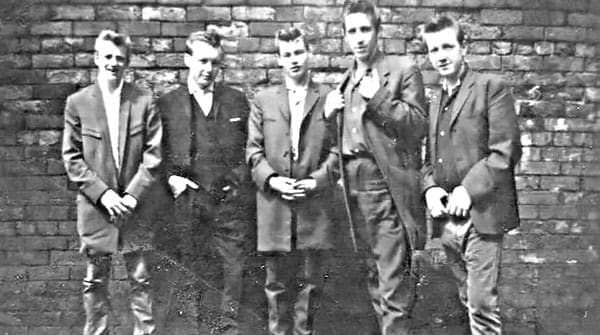The Teddy Boys were Britain’s first working-class youth counterculture
 The 1950s Teddy Boys were an urban British phenomenon, albeit one that crossed the Irish Sea to my Dublin hometown. As the apparent embodiment of unsociable – sometimes thuggish – behaviour, they seemed to be harbingers of a world going to hell in a handbasket.
The 1950s Teddy Boys were an urban British phenomenon, albeit one that crossed the Irish Sea to my Dublin hometown. As the apparent embodiment of unsociable – sometimes thuggish – behaviour, they seemed to be harbingers of a world going to hell in a handbasket.
The Teds, as they were called for short, have been characterized as “Britain’s first working-class youth counterculture.” Coming to the fore as post-war austerity was beginning to lose its grip, they were perceived as disrespectful of conventional manners and mores, menacing in disposition, and susceptible to violence. All in all, a thoroughly disreputable lot!
The name came from their signature mode of dress: long Edwardian-style drape jackets, often with velvet collar and cuffs; skinny shoelace ties; drainpipe trousers; and crepe-soled slip-on shoes. It was an identity-proclaiming uniform rather than just a sartorial fashion. You were letting the world know who you were.
 |
| More from Pat Murphy |
| Ruth Ellis the last hanged woman in Britain
|
| Is it rude to point out the historical inaccuracies in Napoleon?
|
| If Britain had stood aside in 1914
|
And the hair was the crowning glory. Heavily greased with a fastidiously combed quiff at the front and a DA (“duck’s arse”) at the back, it was the antithesis of the “short back and sides” worn by most males of all generations. As the joke went, surely the saddest sight in the world would be a bald Teddy Boy!
The phenomenon first showed up on my radar in 1956. It wasn’t a matter of any personal involvement – at 11 going on 12, I was way too young. And even if I’d been several years older, my aspirational middle-class parents would never have stood for it.
When the 1956 movie Rock Around the Clock arrived in Dublin cinemas, the British precedent of rampaging Teddy Boys slashing theatre seats came with it. Naturally, it was the fodder for dramatic newspaper stories, outraged comment and demands that this imported “foreign contagion” be stamped out.
Some people blamed rock ‘n’ roll, whereas others ascribed it to the lamentable rise of juvenile delinquency and the concurrent discovery of a separate social category known as “teenagers.”
Cardinal Stritch, Archbishop of Chicago, may have captured adult trepidation best. His Lenten Pastoral Letter, quoted in the Irish Independent, described rock & roll music as “tribal rhythms which have a certain vogue in our day.” As he put it, such a “throwback to tribalism in recreation cannot be tolerated for Catholic youths.”
For a while that summer, tales of the Teddy Boys were commonplace. In addition to unruly and destructive behaviour, they were associated with gang violence. Items like knuckledusters and razor blades were purportedly deployed as weapons.
One story had it that resourceful Teds would secrete blades in the lapels of their drape jackets. So if a rival Ted had the effrontery to grab your lapels in the process of an altercation, he’d get a nasty surprise.
Allegedly, a whiff of such activity occurred in my own sleepy suburban village. At least that was the story relayed by my gleeful mates who claimed to have witnessed it.
One summer Sunday, several Teds from a couple of miles down the road turned up for the matinee performance at our cinema and proceeded to engage in physical argy-bargy with the male ushers. Then the local Teds intervened, rescued the ushers and expelled the invaders, who wound up beating a hasty retreat via public transportation. Local solidarity had triumphed and the Teds were (briefly) heroes.
Whether this was true, embellished or wholly fabricated, I can’t say. But it was consistent with the sort of thing people found credible at the time.
Still, the Teddy Boys had their defenders, arguing that the hooliganism of a small minority was unfairly besmirching a relatively harmless broader group.
In the English midlands, a Baptist minister took the initiative to invite a bunch of Teds and their girlfriends to a church social, an event dubbed the Teddy Boys Picnic. And while some of the behaviour was unconventional – smoking during the hymns being an example – the event was deemed a success. The Teds were generally polite, even helping pass around the refreshments, and a church worker said they were “the nicest young folk you could hope to meet.”
Then as the 50s morphed into the 60s, Teddy Boys more or less vanished from public consciousness. To quote a review of a British book on the period, “Teds were everywhere in pulp novels, films and television shows until suddenly they weren’t.”
Fame, even notoriety, can be ruthlessly ephemeral.
Troy Media columnist Pat Murphy casts a history buff’s eye at the goings-on in our world. Never cynical – well, perhaps a little bit.
For interview requests, click here.
The opinions expressed by our columnists and contributors are theirs alone and do not inherently or expressly reflect the views of our publication.
© Troy Media
Troy Media is an editorial content provider to media outlets and its own hosted community news outlets across Canada.
